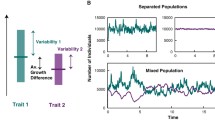Summary
The importance of constraints, defined as factors that retard or prevent a population from reaching its immediate adaptive peak on an ecological time scale is analysed. This is done by means of simple quantitative genetic models, which if anything underestimate the importance of constraints. The results show that even in the simplest case the response to selection will not generally be in the same direction as the selection vector, i.e. the direction to the nearest optimum. Adding complexity identifies cases where selection may lead the population in suboptimal directions. It is concluded that information about univariate genetic variances is not sufficient to predict evolutionary responses and may even be misleading. However, genetic covariances are not always acting as constraints, but can under certain circumstances promote evolution towards the nearest optimum. This can be understood by a spectral decomposition of the genetic variance—covariance matrix, where it is shown that the eigenvector associated with the largest amount of variance will to various degrees determine the outcome of selection. A literature survey of the pattern of character covariation in morphological characters in natural populations shows a wide variety of correlation patterns, but quite often shows a high level of covariance between traits. This suggests that constraints to short-term evolution may be more common than generally appreciated.
Similar content being viewed by others
References
Alberch, P. (1982) Developmental constraints in evolutionary processes. InEvolution and Development (J.T. Bonner, ed.), pp. 313–32. Springer-Verlag, Berlin.
Atchley, W.R. and Hall, B.K. (1991) A model for development and evolution of complex morphological structures.Biol. Rev. 66 101–57.
Björklund, M. (1991) Patterns of morphological variation among cardueline finches (Fringillidae: Carduelinae).Biol. J. Linn. Soc. 43 239–48.
Björklund, M. (1993) Phenotypic variation of growth trajectories in finches.Evolution 47 1506–14.
Björklund, M. (1994a) Species selection on organismal integration.J. Theor. Biol. 171 427–30.
Björklund, M. (1994b) Processes generating macroevolutionary patterns of morphological variation in birds: a simulation study.J. Evol. Biol. 7 727–42.
Björklund, M. and Merilä, J. (1993) Morphological differentation inCarduelis finches: adaptive vs. constraint models.J. Evol. Biol. 6 359–73.
Brodie, E.D., III (1993) Homogeneity of the genetic variance—covariance matrix for antipredator traits in two natural populations of the Garter snakeThamnophis ordinoides.Evolution 47 844–54.
Cowley, D.E. and Atchley, W.R. (1992) Quantitative genetic models for development, epigenetic selection, and phenotypic evolution.Evolution 46 495–518.
Gould, S.J. (1989) A developmental constraint inCerion, with comments on the definition and interpretation of constraint in evolution.Evolution 43 516–39.
Hill, W.G. and Thompson, R. (1978) Probabilities of non-positive definite between-group or genetic covariance matrices.Biometrika 34 429–39.
Jolicoeur, P. and Mosiman, J.E. (1960) Size and shape variation in the painted turtle: a principal component analysis.Growth 24 339–54.
Kirkpatrick, M. (1988) The evolution of size in size-structured populations. InSize-structured Populations (B. Ebenman and L. Persson, eds), pp. 13–28. Springer-Verlag, Berlin.
Kirkpatrick, M. and Lande, R. (1989) The evolution of maternal characteristics.Evolution 43 485–503.
Kirkpatrick, M. and Lofsvold, D. (1992) Measuring selection and constraint in the evolution of growth.Evolution 46 954–71.
Kohn, L.A.P. and Atchley, W.R. (1988) How similar are genetic correlation structures? Data from mice and rats.Evolution 42 467–81.
Lande, R. (1979) Quantitative genetic analysis of multivariate evolution, applied to brain:body size allometry.Evolution 33 402–16.
Lande, R. and Arnold, S.J. (1983) The measurement of selection on correlated characters.Evolution 37 1210–26.
Loeschcke, V. (1987)Genetic Constraints on Adaptive Evolution. Springer-Verlag, Berlin.
Maynard Smith, J., Burian, R., Kauffman, S., Alberch, P., Campell, J., Goodwin, B., Lande, R., Raup, D. and Wolpert, L. (1985) Developmental constraints and evolution.Q. Rev. Biol. 60 265–87.
Mayo, O. (1983)Natural Selection and its Constraints. Academic Press, New York.
Merilä, J., Björklund, M. and Gustafsson, L. (1994) Evolution of morphological differences with moderate genetic correlations among traits as exemplified by two flycatcher species (Ficedula: Muscicapidae).Biol. J. Linn. Soc. 52 19–30.
Morrison, D. F (1990)Multivariate Statistical Methods. McGraw Hill, New York.
Mousseau, T.A. and Roff, D.A. (1987) Natural selection and the heritability of fitness components.Heredity 59 181–97.
Stearns, S.C. (1982) The role of development in the evolution of life histories. InEvolution and Development (J.T. Bonner, ed.), pp. 237–58. Springer-Verlag, Berlin.
Turelli, M. (1988) Phenotypic evolution, constant covariances, and the maintenance of additive variance.Evolution 42 1342–7.
Turelli, M. and Barton, N.H. (1990) Dynamics of polygenic characters under selection.Theor. Pop. Biol. 38 1–57.
Wagner, G.P. (1984) On the eigenvalue distribution of genetic and phenotypic dispersion matrices: evidence for a nonrandom organization of quantitative character variation.J. Math. Biol. 21 77–95.
Williams, G.C. (1992)Natural Selection: Domains, Levels and Challenges. Oxford University Press, Oxford
Wright, S. (1968)Evolution and the Genetics of Populations I: Genetics and Biometric Foundations. Chicago University Press, Chicago, IL.
Zeng, Z.-B. (1988) Long-term correlated response, interpopulation covariance, and interspecific allometry.Evolution 42 363–74.
Author information
Authors and Affiliations
Rights and permissions
About this article
Cite this article
Björklund, M. The importance of evolutionary constraints in ecological time scales. Evol Ecol 10, 423–431 (1996). https://doi.org/10.1007/BF01237727
Issue Date:
DOI: https://doi.org/10.1007/BF01237727




